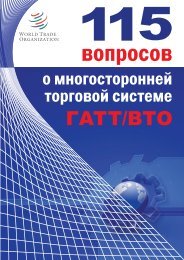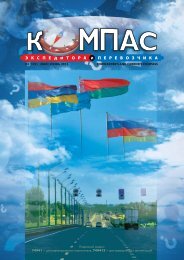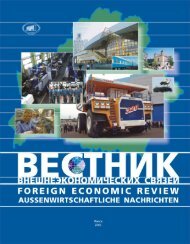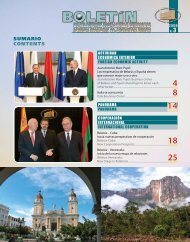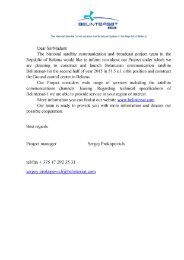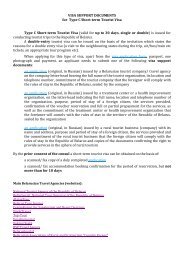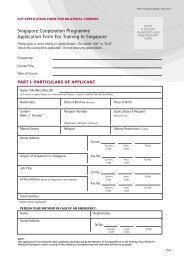Advancing health requiresmore than high-qualityhealth services.Many countries arediscovering that they needsimultaneous interventionson multiple frontsof schooling for people ages 15 and older inrural areas rose from 4.7 years to 6.8.• Uganda. School fees for primary educationwere abolished in Uganda in 1997 with theaim of universalizing primary education.Initially this strained the education infrastructure.98 To improve quality, the Ministryof Education emphasized five areas: curriculumdevelopment, basic learning materials,teacher training, language of instructionand quality standards. The early drops inquality and completion rates have since beenreversed, and the gains have been solidifiedand extended.• Brazil. State-led investments in educationhave dramatically improved developmentoutcomes in Brazil. The transformation ofeducation started with the equalization offunding across regions, states and municipalities.The national <strong>Development</strong> Fundfor Primary Education, created in 1996,guaranteed national minimum spending perstudent in primary education, increasingthe resources for primary students in theNortheast, North and Centre West states,particularly in municipally run schools.Funding “followed the student”, providinga significant incentive for school systemsto expand enrolment. Similarly, states wererequired to share resources across municipalitiesso that all state and municipalschools could reach the per student spendingthreshold. As a result of this investment,Brazil’s math scores on the Programme forInternational Student Assessment rose 52points between 2000 and 2009, the thirdlargestleap on record.Access to high-quality health careAdvancing health requires more thanhigh-quality health services. Previous <strong>Human</strong><strong>Development</strong> <strong>Report</strong>s have shown that humanpoverty is multidimensional. Many countriesare discovering that they need simultaneousinterventions on multiple fronts. Algeria,Morocco and Tunisia, for example, have seenstriking gains in life expectancy in the last 40years. Possible explanations include improvementsin health and drug technology, widespreadvaccinations, information technologyadvances, better access to improved water andsanitation, increased energy provision, andpublic and private investments in health.• Bangladesh. To improve child survivalrates, Bangladesh has taken a multisectoralapproach: expanding education and employmentopportunities for women; improvingwomen’s social status; increasing politicalparticipation, social mobilization and communityparticipation; disseminating publichealth knowledge; and providing effective,community-based essential health services(box 3.7).Health service provision has been heavilyskewed towards the better-off, who havebeen more likely to have good access to thepublic services and pay for private ones.Those with greatest access to health carehave been workers in the formal sector, whohave partly financed their needs with annualcontributions. Workers in the informal sectorare more difficult to provide for. In India, forexample, there are no clearly identified regularemployers who can contribute on behalfof the estimated 93% of the workforce in theinformal sector. 99Everyone should be entitled to the samequality of health care, and several countrieshave attempted to provide and finance universalhealth coverage. Some have done so throughpublic health services targeted to the poor.This is neither desirable nor efficient, generallyresulting in a health care system in which poorpeople receive inferior quality services, often inpublic facilities, while the nonpoor get betterhealth care services from the private sector.Health services targeted to the poor generallyremain underfunded partly because the morepowerful people who are not poor have nostake in making the system better. Also, specialinsurance schemes for the poor miss theadvantages of pooling risks across the wholepopulation and are thus likely to become financiallyunviable, often diverting resources frompreventive and primary care to more-expensivetertiary care.Governments also attempt to finance healthcare through user fees. However, there is nearunanimous consensus now that such fees haveadverse consequences, especially for the poor.They discourage the poor from using servicesand generally mobilize little in terms ofresources. 10080 | HUMAN DEVELOPMENT REPORT <strong>2013</strong>
BOX 3.7Bangladesh makes dramatic advances in child survivalIn 1990, the infant mortality rate in Bangladesh, 97 deaths per 1,000 livebirths, was 16% higher than India’s 81. By 2004, the situation was reversed,with Bangladesh’s infant mortality rate (38) 21% lower than India’s (48).Three main factors seem to explain the dramatic improvements.First, economic empowerment of women through employment inthe garment industry and access to microcredit transformed their situation.The vast majority of women in the garment industry are migrantsfrom rural areas. This unprecedented employment opportunity for youngwomen has narrowed gender gaps in employment and income. Thespread of microcredit has also aided women’s empowerment. GrameenBank alone has disbursed $8.74 billion to 8 million borrowers, 95% ofthem women. According to recent estimates, these small loans haveenabled more than half of borrowers’ households to cross the povertyline, and new economic opportunities have opened up as a result ofeasier access to microcredit. Postponed marriage and motherhood aredirect consequences of women’s empowerment, as are the effects onchild survival.Second, social and political empowerment of women has occurredthrough regular meetings of women’s groups organized by nongovernmentalorganizations. For example, the Grameen system has familiarized borrowerswith election processes, since members participate in annual electionsfor chairperson and secretaries, centre-chiefs and deputy centre-chiefs, aswell as board member elections every three years. This experience has preparedmany women to run for public office. Women have also been sociallyempowered through participation in the banks. A recent analysis suggestsmuch better knowledge about health among participants in credit forumsthan among nonparticipants.Third, the higher participation of girls in formal education has been enhancedby nongovernmental organizations. Informal schools run by the nongovernmentalorganization BRAC offer four years of accelerated primaryschooling to adolescents who have never attended school, and the schoolshave retention rates over 94%. After graduation, students can join the formalschooling system, which most do. Monthly reproductive health sessionsare integrated into the regular school curriculum and include such topics asadolescence, reproduction and menstruation, marriage and pregnancy, familyplanning and contraception, smoking and substance abuse, and genderissues. Today, girls’ enrolment in schools exceeds that of boys (15 years ago,only 40% of school attendees were girls).Women’s empowerment has gone hand-in-hand with substantial improvementsin health services and promotion. With injectable contraceptives,contraceptive use has surged. Nearly 53% of women ages 15–40 nowuse contraceptives, often through services provided by community outreachworkers. BRAC also provided community-based instruction to more than13 million women about rehydration for children suffering from diarrhoea.Today Bangladesh has the world’s highest rate of oral rehydration use, anddiarrhoea no longer figures as a major killer of children. Almost 95% of childrenin Bangladesh are fully immunized against tuberculosis, compared withonly 73% in India. Even adult tuberculosis cases fare better in Bangladesh,with BRAC-sponsored community volunteers treating more than 90% ofcases, while India struggles to reach 70% through the formal health system.Source: BRAC n.d.; Grameen Bank n.d.; World Bank 2012a.The lesson from global experience is that themain source of financing for universal healthcare should be taxation. Most countries inSoutheast Asia, for example, have embracedthe idea. Governments have sought to reduceprivate out-of-pocket spending, increasepooled health finance and improve the reachand quality of health services, although coveragevaries. 101 Identifying and reaching poorpeople remain challenges, and resource-poordeveloping countries such as Lao PDR andViet Nam have relied heavily on donor-supportedhealth equity funds.• Thailand. Thailand’s 2002 National HealthSecurity Act stipulated that every citizenshould have comprehensive medical care.By 2009, 76% of the population, about48 million people, were registered in theUniversal Health Coverage Scheme, whichprovides free inpatient and outpatienttreatment, maternity care, dental care andemergency care. The scheme is fully financedby the government, with a budget in 2011 of$34 million—$70 for each insured person—which accounts for 5.9% of the nationalbudget. 102• Mexico. In 2003, the Mexican state approvedSeguro Popular, a public insurancescheme that provides access to comprehensivehealth care for poor householdsformerly excluded from traditional socialsecurity. Public resources for health haveincreased and are being distributed morefairly. Access to and use of health care serviceshave expanded. Financial protectionindicators have improved. By the end of2007, 20 million poor people were benefitingfrom the scheme. 103 Mexico is a leaderin moving rapidly towards universal healthcoverage by adopting an innovative financingmechanism.• Rwanda. Access to health services hasbeen expanded in Rwanda by introducingcommunity- based health insurance. HealthChapter 3 Drivers of development transformation | 81
- Page 1 and 2:
WNSEHuman DevelopmentReport 2013The
- Page 3 and 4:
Human Development Report 2013The Ri
- Page 5 and 6:
Human Development Report 2013 TeamD
- Page 7 and 8:
Finally, the Report also calls for
- Page 9 and 10:
Heather Simpson, Ben Slay, Mounir T
- Page 11 and 12:
3.6 India’s Supreme Court issues
- Page 13 and 14:
OverviewOne of the most heartening
- Page 15 and 16:
and sustainability are fully incorp
- Page 17 and 18:
Without investment in people, retur
- Page 19 and 20:
opportunity to reap the full benefi
- Page 21 and 22:
Woods institutions, the United Nati
- Page 23 and 24:
IntroductionWhen developed economie
- Page 25 and 26:
leading economies—Brazil, China a
- Page 27 and 28:
comparable access to information, e
- Page 29 and 30:
mobile phones: cellular banking is
- Page 32 and 33:
“The political problem ofmankind
- Page 34 and 35:
BOX 1.1Fairness, macroeconomics and
- Page 36 and 37:
BOX 1.3Amartya Sen, Nobel Laureate
- Page 38 and 39:
FIGURE 1.1Income per capita is risi
- Page 40 and 41:
BOX 1.4Subjective indicators of wel
- Page 42 and 43: FIGURE 1.4There is notable variatio
- Page 44 and 45: FIGURE 1.6Most regions show declini
- Page 46 and 47: Progress in humandevelopment achiev
- Page 48 and 49: BOX 1.7Social competencies: human d
- Page 50 and 51: TABLE 1.3Inequality and satisfactio
- Page 52 and 53: Not all countries havethe precondit
- Page 54 and 55: “When the music changes,so does t
- Page 56 and 57: BOX 2.1The South’s integration wi
- Page 58 and 59: FIGURE 2.1As a share of world merch
- Page 60 and 61: BOX 2.2Acquisitions by the South of
- Page 62 and 63: FIGURE 2.3Between 2000 and 2010, In
- Page 64 and 65: FIGURE 2.4Export earnings per capit
- Page 66 and 67: BOX 2.6Final assembly is about more
- Page 68 and 69: Instead of having a centreof indust
- Page 70 and 71: FIGURE 2.6Emerging market economies
- Page 72 and 73: Developing countriestrade more amon
- Page 74 and 75: “We cannot expect thatall nations
- Page 76 and 77: TABLE 3.1Selected developing countr
- Page 78 and 79: A common featureof countries thatha
- Page 80 and 81: More important thangetting prices r
- Page 82 and 83: BOX 3.5Eastern Europe and Central A
- Page 84 and 85: States have to beconscious that the
- Page 86 and 87: As countries develop,they tend to d
- Page 88 and 89: Having weathered theAsian financial
- Page 90 and 91: Providing publicservices that contr
- Page 94 and 95: Universal public healthand educatio
- Page 96 and 97: • China. The Minimum Livelihood G
- Page 98 and 99: “Each generation will reap whatth
- Page 100 and 101: concerns will make for a complex en
- Page 102 and 103: A greater emphasison education cans
- Page 104 and 105: FIGURE 4.1Under the fast track scen
- Page 106 and 107: Around the worldpeople are calling
- Page 108 and 109: FIGURE 4.4Different environmental s
- Page 110 and 111: FIGURE 4.5Education policies can al
- Page 112 and 113: BOX 4.2China and Ghana: who benefit
- Page 114 and 115: FIGURE 4.8countries thus converge t
- Page 116 and 117: “Let us join hands to try tocreat
- Page 118 and 119: Areas of globalinternational concer
- Page 120 and 121: Addressing climatechange requires t
- Page 122 and 123: International governanceis increasi
- Page 124 and 125: BOX 5.2Jo Leinen, Member of the Eur
- Page 126 and 127: facilitates reserve investments and
- Page 128 and 129: Responsible sovereigntytakes the lo
- Page 130 and 131: FIGURE 5.1Under the accelerated pro
- Page 132 and 133: Good policymakingrequires greater f
- Page 134 and 135: A fair and less unequalworld requir
- Page 137 and 138: NotesOverview1 Atsmon and others 20
- Page 139 and 140: 25 Blinder 2006.26 UNIDO 2009.27 UN
- Page 141 and 142: which is 61.7 deaths per 1,000 live
- Page 143 and 144:
ReferencesAbdurazakov, A., A. Minsa
- Page 145 and 146:
urban_world_cities_and_the_rise_of_
- Page 147 and 148:
Kamau, P., D. McCormick, and N. Pin
- Page 149 and 150:
Labor Administration. Geneva: Inter
- Page 151 and 152:
Human Development Report 2013The Ri
- Page 153 and 154:
Statistical acknowledgementsThe Rep
- Page 155 and 156:
Key to HDI countries and ranks, 201
- Page 157 and 158:
Human Development Report 2013The Ri
- Page 159 and 160:
Human Development Report 2013The Ri
- Page 161 and 162:
Human Development Report 2013The Ri
- Page 163 and 164:
Human Development Report 2013The Ri
- Page 165 and 166:
Human Development Report 2013The Ri
- Page 167 and 168:
Human Development Report 2013The Ri
- Page 169 and 170:
Human Development Report 2013The Ri
- Page 171 and 172:
Human Development Report 2013The Ri
- Page 173 and 174:
Human Development Report 2013The Ri
- Page 175 and 176:
Human Development Report 2013The Ri
- Page 177 and 178:
Human Development Report 2013The Ri
- Page 179 and 180:
Human Development Report 2013The Ri
- Page 181 and 182:
Human Development Report 2013The Ri
- Page 183 and 184:
Human Development Report 2013The Ri
- Page 185 and 186:
Human Development Report 2013The Ri
- Page 187 and 188:
Human Development Report 2013The Ri
- Page 189 and 190:
Human Development Report 2013The Ri
- Page 191 and 192:
Human Development Report 2013The Ri
- Page 193 and 194:
Human Development Report 2013The Ri
- Page 195 and 196:
Human Development Report 2013The Ri
- Page 197 and 198:
Human Development Report 2013The Ri
- Page 199 and 200:
Human Development Report 2013The Ri
- Page 201 and 202:
Human Development Report 2013The Ri
- Page 203 and 204:
Human Development Report 2013The Ri
- Page 205 and 206:
Human Development Report 2013The Ri
- Page 207 and 208:
Human Development Report 2013The Ri
- Page 209 and 210:
Human Development Report 2013The Ri
- Page 211 and 212:
Statistical referencesADB (Asian De
- Page 213 and 214:
Core features of the model pertinen
- Page 215 and 216:
Countries and HDI ranks in 2012 and




